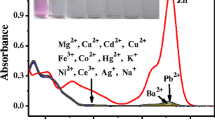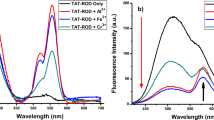Abstract
In the paper, a novel rhodamine6G based fluorescent chemosensor bearing 3-carbaldehyde chromone was designed and synthesized. According to the fluorescence behavior toward several metal ions, it showed highly selectivity and sensitivity to Zn(II) over other commonly coexistent metal ions (Cu(II), Cd(II), Hg(II), Mg(II), K(I), Pb(II), Fe(III) and Cr(III)) in aqueous environment (pH = 7.4). Meanwhile the binding constant between Zn(II) and chemosensor achieved 6.21 × 1011 M−1 in aqueous media. Moreover, according to the Job plot, 1:1 stoichiometry between Zn(II) and sensor was deduced in aqueous media (pH = 7.4). The good selectivity and sensitivity in aqueous media effectively enhanced the application value of the fluorescent chemosensor for Zn(II).









Similar content being viewed by others
References
Liu Y, Zhang SW, Miao Q, Zheng LF, Zong LL, Cheng YX (2007) Fluorescent chemosensory conjugated polymers based on optically active polybinaphthyls and 2,2′-bipyridyl units. Macromolecules 40:4839–4847
Callan JF, de Silva AP, Magria DC (2005) Luminescent sensors and switches in the early 21st century. Tetrahedron 61:8551–8588
Kim JS, Quang DT (2007) Calixarene-derived fluorescent probes. Chem Rev 107:3780–3799
Nolan EM, Lippard SJ (2009) Chemosensors for pyrophosphate. Acc Chem Res 42:23–31
Clark MA, Duffy K, Tibrewala J, Lippard SJ (2003) Synthesis and metal-binding properties of chelating fluorescein derivatives. Org Lett 5:2051–2054
Wu DY, Huang W, Duan CY, Lin ZH, Meng QJ (2007) Highly sensitive fluorescent probe for selective detection of Hg2+ in DMF aqueous media. Inorg Chem 46:1538–1540
Wu JS, Hwang IC, Kim KS, Kim JS (2007) Rhodamine-based Hg2+-selective chemodosimeter in aqueous solution: fluorescent OFF-ON. Org Lett 9:907–910
Zhang JF, Zhou Y, Yoon JY, Kim YM, Kim JS (2010) Naphthalimide modified rhodamine derivate: ratiometric an selective fluorescent sensor for Cu2+ based on two different approaches. Org Lett 12:3852–3855
Chen XQ, Nam SW, Jou MJ, Kim YM, Kim SJ, Park SS, Yoon JY (2008) Hg2+ selective fluorescent and colorimetric sensor: its crystal structure and application to bioimaging. Org Lett 10:5235–5238
Yang YK, Cho HSJ, Lee JY, Shin IJ, Tae JS (2009) A rhodamine-hydroxamic acid-based fluorescent probe for hypochlorous acid and its applications to biological imagings. Org Lett 11:859–861
Vallee BL, Falchuk KH (1993) The biochemical basis of zinc physiology. Phys Rev 73:79–118
Frederickson CJ, Koh J-Y, Bush AI (2005) The neurobiology of zinc in health and disease. Nat Rev Neurosci 6:449–462
Lippard SJ, Berg JM (1994) Principle of bioinogranic chemistry. University Science Book, CA, p 10, 14: 78–183
McRae R, Bagchi P, Sumalekshmy S, Fahrni CJ (2009) In situ imaging of metals in cells and tissues. Chem Rev 109:4780–4827
Voegelin A, Jacquat O, Pfister S, Barmettler K, Scheinost AC, Kretzschmar R (2011) Time-dependent changes of zinc speciation in four soils contaminated with zincite or sphalerite. Environ Sci Technol 45:255–261
Hisaindee S, Zahid O, Meetani MA, Graham J (2012) Fluorescent studies of salicylaldehyde and other related carbonyl compounds for the selective and sensitive detection of zinc(II) ions in aqueous solution. J Fluoresc 22:677–683
Lu XY, Zhu WH, Xie YS, Li X, Gao Y, Li FY, Tian H (2010) Near-IR core-substituted naphthalenediimide fluorescent chemosensors for zinc ions: ligand effect on PET and ICT channels. Chem Eur J 16:8355–8364
Xu Z, Baek K-H, Kim HN, Cui J, Qian X, Spring DR, Shin I, Yoon J (2010) Zn2+ triggered amide tautomerization produces a highly Zn2+ selective, cell-permeable and ratiometric fluorescent sensor. J Am Chem Soc 132:601–610
Zhou Y, You XY, Fang Y, Li JY, Liu K, Yao C (2010) A thiophen-thiooxorhodamine conjugate fluorescent probe for detecting mercury in aqueous media and living cells. Chem Commun 8:4819–4822
Buccella D, Horowitz JA, Lippard SJ (2011) Understanding zinc quantification with existing and advanced ditopic fluorescent Zinpyr sensors. J Am Chem Soc 133:4104–4114
Yoon S, Albers AE, Wong AP, Chang CJ (2005) Screening mercury levels in fish with a selective fluorescent chemosensor. J Am Chem Soc 127:16030–16031
Zhou Y, Wang F, Kim YM, Kim SJ, Yoon JY (2009) Cu2+-selective ratiometric and “off-on” sensor based on the rhodamine derivative bearing pyrene group. Org Lett 11:4442–4445
Liu ZC, Wang BD, Yang ZY, Li TR, Li Y (2009) Synthesis, crystal structure, DNA interaction and antioxidant activities of two novel water-soluble Cu(2+) complexes derivated from 2-oxo-quinoline-3-carbaldehyde Schiff-bases. Eur J Med Chem 44:4477–4484
Yang Y-K, Yook K-J, Tae J (2005) A rhodamine-based fluorescent and colorimetric chemodosimeter for the rapid detection of Hg2+ ions in aqueous media. J Am Chem Soc 127:16760–16761
Nohara A, Umetani T, Sanno Y (1973) 1A facile synthesis of chromone-3- carboxaldehyde, chromone-3-carboxylic acid and 3-hydroxymethylchromone. Tetrahedron Lett 14:995–1998
Li Y, Yang ZY, Li TR, Liu ZC, Wang BD (2011) Synthesis, characterization, DNA binding properties and antioxidant activity of Ln(III) complexes with Schiff base ligand derived from 3-carbaldehyde chromone and aminophenazone. J Fluoresc 21:1091–1102
Benesi HA, Hildebrand JH (1949) A spectrophotometric investigation of the interaction of iodine with aromatic hydrocarbons. J Am Chem Soc 71:2703–2707
Wang BD, Hai J, Liu ZC, Wang Q, Yang ZY, Sun SH (2010) Selective detection of iron(III) by rhodamine-modified Fe3O4 nanoparticles. Angew Chem Int Ed 49:4576–4579
Acknowledgments
This work is supported by the Research Start Funds Sponsored Program of Zhoukou Normal University (zksybscx201201) and the National Natural Science Foundation of China (81171337, 21271093).
Author information
Authors and Affiliations
Corresponding author
Rights and permissions
About this article
Cite this article
Liu, Zc., Yang, Zy., Li, Yx. et al. A Highly Selective Turn-On Fluorescent Chemosensor for Zinc Ion in Aqueous Media. J Fluoresc 23, 1239–1245 (2013). https://doi.org/10.1007/s10895-013-1255-1
Received:
Accepted:
Published:
Issue Date:
DOI: https://doi.org/10.1007/s10895-013-1255-1




